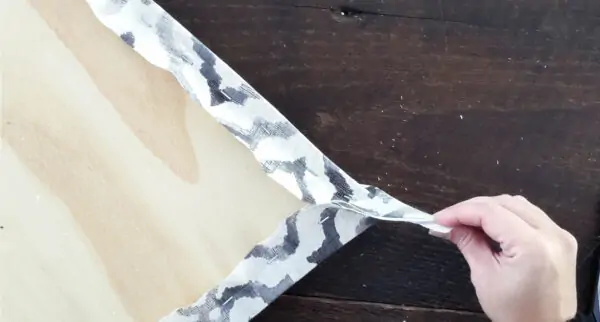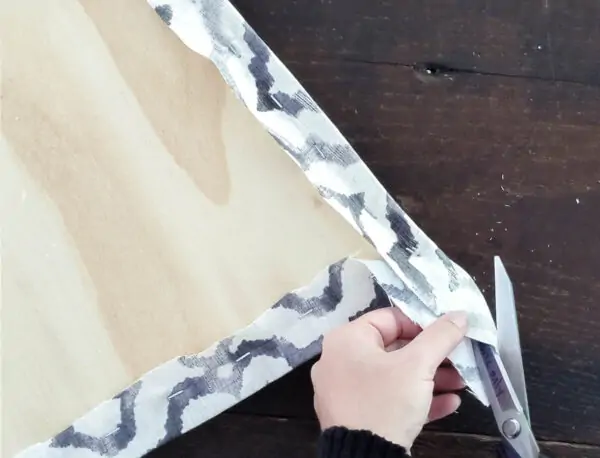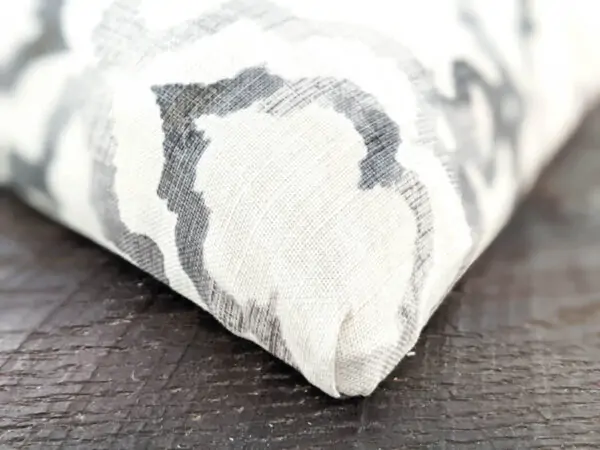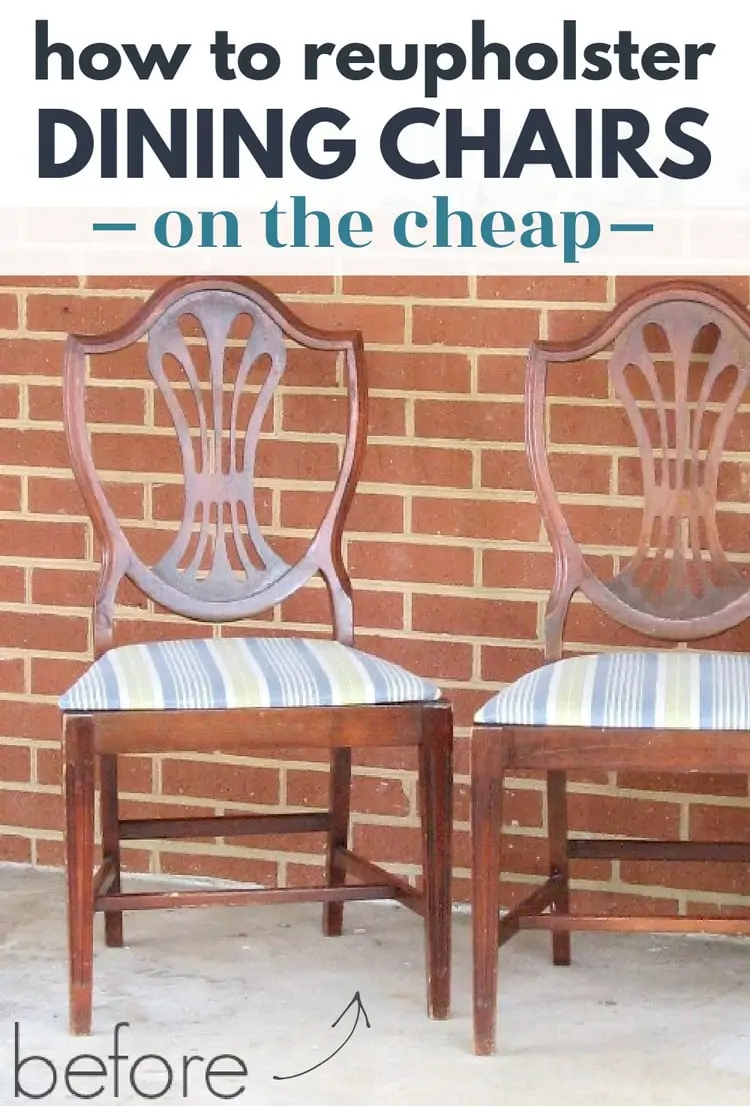How to Reupholster Dining Chairs and Get Perfectly Smooth Corners
This simple step-by-step tutorial will show you how to reupholster dining chairs, including how to get perfectly upholstered corners.
Reupholstering dining chairs is hands down the easiest upholstery project there is. Even if you’re a complete beginner, you can definitely handle this.
I’m reupholstering the wooden chairs in our dining room. This is actually the second time I’ve reupholstered them. This is how they looked when I got them at a yard sale.

Good solid wood chairs, but way too traditional for my taste.
So I gave them a fresh coat of teal paint and some new upholstery and they looked amazing.
But it’s been more than seven years since I first reupholstered these chairs and during that time my three small boys have definitely left their mark. So now that we no longer have toddlers in the house, I’m excited to give them some fresh, new fabric!
I’m sharing a simple step-by-step tutorial for upholstering dining chairs along with a video tutorial. And I’m also including tips for saving money on materials and showing how to get smooth corners, which is honestly the only part that can be a bit tricky.

Choosing the right fabric
When you are choosing fabric for dining chairs, you want to to choose something sturdy that is also somewhat stain-resistant.
It’s best to use an upholstery weight or home decor fabric because these fabrics are a bit thicker and will hold up better over time.
Outdoor fabric is also a great choice – it’s not only a bit more heavy-duty, it also holds up well against spills.
I’ve also used shower curtains, tablecloths, and window curtains for upholstery projects in the past. This is a great way to get high quality, beautiful fabric for way cheaper than if you bought it from a fabric store.
I particularly love shower curtains and outdoor table cloths for upholstering dining chairs. They’re typically a nice thick fabric and they hold up really well to moisture and frequent cleaning.
One shower curtain or tablecloth usually has enough fabric to reupholster an entire set of 4-6 chairs and I can usually find great choices for cheap at stores like HomeGoods and TJMaxx.
(And if you’re interested, I have a whole post about nontraditional ways to get fabric for all your projects for cheap.)
How much fabric do you need to reupholster dining chairs?
For each chair you are recovering, you’ll need a piece of fabric that is four inches longer and wider than your chair seat. You want to make sure there is enough fabric to wrap around your chair seats and staple underneath.
If your chair seats are extra thick, you may need a few extra inches of fabric for each seat.
My chairs are 19″x20″ and I used 1.5 yards to upholster four chairs.
This post contains affiliate links which means if you make a purchase after clicking a link I will earn a small commission but it won’t cost you a penny more. Click here to see my full disclosure policy.
Materials
- Chairs to Upholster
- Fabric of your choice
- Upholstery foam – you can reuse the foam that was previously on your chairs, but if it has gotten worn down over time, your chairs will be more comfortable and last longer with fresh foam
- Batting – Again, you can reuse what was already on your chairs if it is still in good condition
- 1/2″ plywood cut to match your old seats – You will only need this if your old seats are completely missing or the old plywood is cracked and broken.
Tools
- Upholstery staple remover – this thing makes removing the old upholstery 100 times easier
- Flathead Screwdriver and Needle nose pliers – if you don’t have an upholstery staple remover, you can use a screwdriver and needle nose pliers to remove the old stapes
- Fabric scissors – I’m not much of a seamstress, so for many years I just used my multipurpose scissors to cut fabric. When I finally got real fabric scissors, I was blown away by how they cut fabric so much easier and better. This is a must have for any fabric DIYs.
- Staple gun – any staple gun will work, it doesn’t have to be fancy or use an air compressor.
- 3/8″ or 1/2″ staples
How to Reupholster a Dining Chair
Remove the old upholstery
The first step is removing the seats from your chairs; usually they are attached underneath with screws.
Once the seats are removed, you can remove the old fabric.
Most upholstery fabric is attached underneath the seat with staples.
One way to remove the staples is to pry them out with a flathead screwdriver and then remove them with needle-nose pliers.

You can also use an upholstery staple remover. It makes the staple-removing process go much faster and it’s definitely worth getting one if you are considering doing more upholstery projects.
Replace the plywood if needed
Dining chair upholstery is typically made of four layers: fabric, batting, foam, and wood. If you are reupholstering chairs that are in really good shape, you will only need to replace the fabric.
But sometimes the other layers are old, dirty, or missing and also need to be replaced.
Once you get your fabric off your chairs, you can check out the wood and the foam that’s underneath and see if it’s in good enough condition to reuse or not.
The thin plywood seats of my own chairs had cracked in several places and I didn’t trust them to last much longer.
So I used the old plywood as a pattern and cut new seats for my chairs from 1/2″ plywood using a jigsaw. Now they will be much more sturdy.
Replace the foam and batting if needed
If your foam still has good bounce and it’s comfortable and it doesn’t look stained or gross, you can definitely reuse it.
On top of the foam, there is usually a layer of thin batting or sometimes a different type of padding. Again, if it’s clean, you can reuse the same batting.
If you need to replace your upholstery foam, 2″ thick foam is the sweet spot.
Upholstery foam can be surprisingly expensive, especially if you need enough for an entire set of chairs. If you are buying your foam at a fabric store like Joanne’s, don’t forget to use a coupon. It will definitely be worth it.
And if that’s still out of your budget, I have gotten inexpensive foam mattress toppers before and cut them to size.
The foam on my own chairs was getting pretty worn out so I’m replacing it with some foam that I have leftover from a previous project. A few months ago when I turned an upholstered bench into a wooden bench for my porch, I saved the foam I removed from it, knowing it would come in handy someday!
You can use your plywood seats as a pattern for cutting your foam.
I cut my foam using my fabric scissors, but an electric knife is really the best thing to use to cut foam. A bread knife also works well, especially when you are cutting thicker foam.
Cut your fabric
Cut your fabric at least four inches longer and wider than your chair seat.
If you are using a patterned fabric, think about how you want the fabric to look on the finished chairs, which way you want the pattern to face, and whether you want it centered before cutting.
If you are also cutting new batting, you can cut the batting the same size as your fabric. (You may notice in the photo below that my batting is a bit smaller; that’s just because I was running out and needed to make do with a smaller piece.)
Lay out the layers of your seat
Now that all of your materials are ready, you can start layering everything.

Start by laying your fabric facedown on your work surface. Lay the batting on top of the fabric, followed by the foam and the wooden seat.
If you are using a patterned fabric, make sure the pattern is straight and centered the way you want.
Staple the fabric in place
You’re going to use a staple gun to attach your fabric underneath the seat.
Any staple gun will work for this. If you are using a manual staple gun, you may find that you need to lean into the seat a bit as you staple to help the staples attach securely. And if you end up with a few staples that are sticking out a bit, you can tap those into place with a hammer.
Start with one staple in the center of each side. Wrap the fabric around each side of the chair, pulling it tight, and then use one staple to hold it in place.

Once you’ve attached all four sides with one staple, you can flip your seat over and make sure the fabric looks straight from the front.
If everything looks good, flip the seat back over and continue stapling along each side, leaving the corners undone for now.
Be sure to continue pulling the fabric tight as you go. The main cause of sloppy looking upholstery is loose, wrinkly fabric.

How to get smooth upholstery corners
Upholstering the corners of your chair is the only part that can get a bit tricky. You end up with a lot of excess fabric in the corners and if you just start stapling it, it makes a bit of a wrinkly mess.
After trying a few different ways of upholstering corners, this is the method I think is the easiest and most straight-forward.
First, we need to secure the fabric along the sides a bit closer to the corner. Imagine there is a line going right through the corner of the chair. As you are stapling your fabric sides near the corner, don’t cross that line.

Now your fabric is secure, it’s time to get rid of some of the excess fabric. Hold up the corner of your fabric so that it makes a triangle then cut out one side of the triangle.
Start by cutting a 1/2″ or so down from the fold of the fabric and then 1/2″ or so about the seat to form a triangle.
Be careful not to cut the other side of the fabric and be careful not to cut too close to the seat. You can always cut away more if needed, but you can’t put it back.

You’ll be left with one triangular flap. The goal is to fold the fabric that is left to create one clean fold at the corner rather than a whole bunch of wrinkles.
To do that, pull the flap of fabric toward the bottom of the chair and tuck all of the excess fabric into the fold as you pull it. You can use your flathead screwdriver if you need a bit of help, tucking in the excess fabric.

Then pull it tight and staple it in place.
Repeat for the other three corners. If you are struggling with this step, there is a video tutorial below that makes it much clearer.

Reattach the chair seats
The last step is to reattach the newly covered seats to your chairs. They almost feel like have brand new chairs!

I chose this fabric because I love how it looks next to the blue of my chairs, but I know it isn’t going to be the best for hiding stains so I’m going to spray a few coats of Scotch Guard before we use them.
And for anyone wondering the paint color on the chairs is Valspar Nightscape and the fabric is Kelly Ripa Multipurpose Decor Fabric in Good Vibes Ebony.
Time and cost to reupholster dining chairs
This is actually a pretty quick project. And if you don’t need to cut new wooden seats for your chairs, it’s really quick.
Each chair takes around 10-20 minutes to upholster depending on if you need to cut new foam and batting. So my entire set of four chairs only took around an hour.
As far as cost, it really depends on whether you need to buy new wood, foam, and batting or just fabric and how expensive the fabric you choose is.
You could reupholster a single chair for as little as $5 (using the shower curtain trick) or it could cost up to $35-40 per chair for new wood, foam, batting, and more expensive fabric.
Since I was able to reuse foam and batting I had on hand, my own chairs cost $50 for all four or $12.50 each for the new fabric and new plywood.
Learning how to reupholster old furniture has opened me up to a whole world of DIY possibilites. If you think you may be ready to tackle some more advanced reupholstery projects, I have lots of tips for reupholstering simple armchairs and as well as a post all about how to reupholster an entire couch for cheap.
Video Tutorial
I’d love for you to subscribe to my Youtube channel!
Other furniture makeover ideas I think you’ll like:

How to Reupholster Dining Chairs
Let me show you how simple it is to reupholster dining chairs. Even if you’re a complete beginner, you can definitely handle this.
Materials
- Chairs to Upholster
- Fabric of your choice
- Batting
- Upholstery foam - you may be able to reuse the old foam
- 1/2″ plywood - if your old seats are missing or broken
Tools
- Upholstery staple remover
- Flathead Screwdriver and Needle nose pliers - if you don't have an upholstery staple remover
- Fabric scissors
- Staple gun
- 3/8″ or 1/2″ staples for staple gun
Instructions
- Remove the seats from your chairs.
- Remove the old fabric by removing the staples. You can remove them with an upholstery staple remover or use a flathead screwdriver and then remove them with needle-nose pliers.
- Replace the plywood if needed. Use the old plywood as a pattern and cut new seats for your chairs with 1/2″ plywood and a jigsaw.
- If your upholstery foam is not in good shape, you can replace it with new 2″ thick foam.
- Cut your fabric at least four inches longer and wider than your chair seat.
- Start by laying your fabric face down on your work surface. Lay the batting on top of the fabric, followed by the foam and the wooden seat.
- Use a staple gun to attach your fabric underneath the seat.
- Start with one staple in the center of each side.
- Wrap the fabric around each side of the chair, pull it tight, and use one staple to hold it in place.
- Continue stapling along each side, leaving the corners undone for now. Be sure to continue pulling the fabric tight as you go.
- Secure the fabric along the sides a bit closer to the corner.
- Start by cutting a 1/2″ or so down from the fold and then 1/2″ or so above the seat to form a triangle.
- Pull the flap of fabric toward the bottom of the chair and tuck all of the excess fabric into the fold as you pull it. Then pull it tight and staple it into place.
Recommended Products
As an Amazon Associate and member of other affiliate programs, I earn from qualifying purchases.
-
ARROW 508 Genuine T50 1/2-Inch Staples, 1,250-Pack
-
LIVINGO Premium Tailor Scissors Heavy Duty Multi-Purpose Titanium Coating Forged Stainless Steel Sewing Fabric Leather Dressmaking Softgrip Shears Professional Crafting (9.5 INCH)
-
Air Locker A01 Upholstery & Construction Heavy-Duty Staple Remover
-
Fairfield X45B Bonded Polyester Batting Crib, 45" x 60", White
I’d love for you to pin this post on Pinterest!








GREAT JOB! I LOVE THE BLUE COLOR.
Thank you!
They look terrific Carrie. We have twinner chairs. I first painted mine a turquoise blue color, now they are black.
Thanks!
This is so simple, and thank you for the pictures as reference!
I’m so glad it helped!
My seats have curved edges. Do you have any ideas for dealing with that? The old fabric was quite flexible, and the new fabric isn’t.
Hmm, that makes it a bit tougher. If it is a gentle curve, you may just be able to pull the fabric tight a little at a time to go around the curve. But I know that may be tough with stiff fabric. You may need to make a few folds in the fabric at even intervals to get it to lay smoothly. Good luck!